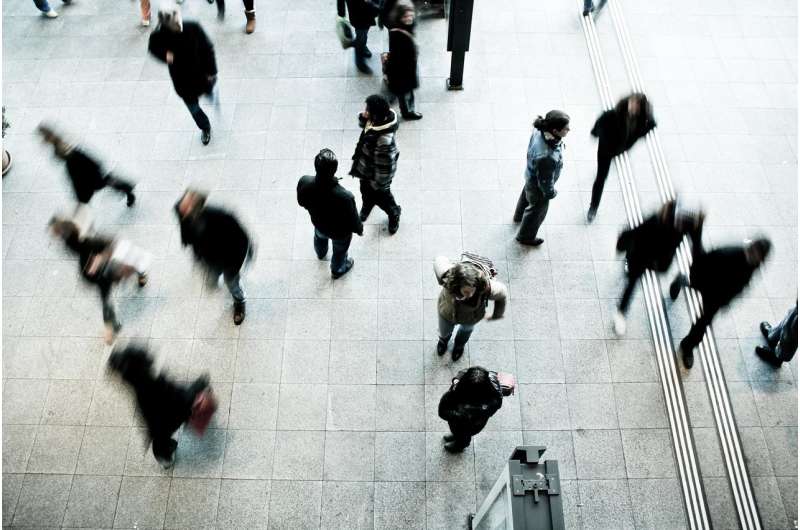Credit: CC0 Public Domain
Transforming the way communities are designed makes it more likely that people across the U.S. will engage in activities such as walking, biking, rolling and using public transportation, according to two new reports published today in the American Heart Association's flagship journal Circulation.
Regular physical activity is one of the most important things people can do to improve their cardiovascular health; however, population levels of physical activity remain low in the United States. A science advisory from the AHA, "Built Environment Approaches to Increase Physical Activity," finds that improving built environments by making it easier and more enticing for people to use active transportation can help increase physical activity.
The advisory finds that by connecting activity-friendly routes to everyday destinations, such as work, school, shopping centers, parks, public transportation hubs and the like, people increase their physical activity levels by walking, biking or rolling, which ultimately improves cardiovascular health in all populations.
"Regular physical activity is associated with a wide array of health benefits, from reducing feelings of anxiety and depression and improving sleep and cognition, to lowering the risk of developing type 2 diabetes, some cancers and heart disease," said lead author John Omura, MD, from the Division of Nutrition, Physical Activity, and Obesity at the Centers for Disease Control and Prevention (CDC). "Effective population-based approaches implemented in communities can help increase physical activity among all Americans. By implementing built environment strategies, communities across the United States can be designed in ways that help promote healthy and active living, increase physical activity, and ultimately improve cardiovascular health for everyone."
However, these improvements are not possible unless government officials at the community, state and federal levels embrace and invest in built environment improvements through policy change, according to the AHA policy statement, "Creating Built Environments That Expand Active Transportation and Active Living Across the United States," which was published alongside the science advisory.
The policy statement concludes that using human-powered, active transportation is one of the leading evidence-based strategies to increase physical activity, regardless of age, income, racial or ethnic background, ability or disability, but that environments must be conducive to such activity.
"Moving people around with safer and sustainable transportation options that integrate walking, bicycling and wheelchair use while connecting routes to all of a region's geographic areas can improve community development, foster economic revitalization, link people to the health care system and jobs, improve air quality and help address climate change," said lead author Deborah Young, Ph.D., director of Behavioral Research in the Department of Research & Evaluation at Kaiser Permanente Southern California. "Providing easy access to green spaces and recreational areas not only encourages physical activity, but contributes to a healthier planet, promotes social interactions within communities and enhances overall health and well-being."
According to the policy statement, there is no single solution to bettering built environments. Instead, community, state and federal governments, along with advocacy groups and community members, must work together to implement policies that will allow for people to feel safe while navigating their cities and towns outside of personal vehicles.
The policy statement supports a multi-pronged built environment approach, including:
- Pedestrian and bicycle infrastructure that makes it easier for people to walk and bike by improving routes, sidewalks, bike lanes, street crossings and street furnishings such as benches, lighting, bike parking and storage or bicycle sharing programs. It is also integral to include people who use wheelchairs and other mobility assistive devices in these plans.
- Complete streets policies that ensure street designs address the needs of all vehicle and non-vehicle users.
- Safe Routes to School programs that enable children to walk, bike and roll to and from school safely. This is especially important due to COVID-19 concerns with crowded school buses.
- Public transit use and the first/last mile challenge improvements that can lead to more physical activity because of the active travel that is often required to get to transit stops and final destinations. First mile/ last mile may be difficult in many areas of the U.S. because of land use patterns in which people live in lower-density areas distant from public transportation or where there are inadequate pedestrian and bicycle facilities between transit stops and trip origin or termination points.
- Traffic Safety/Vision Zero plans that work to achieve a transportation system with no fatalities.
- Street-scale design and placemaking that make improvements to the walkability of communities by enhancing the experience people who walk bike, roll and use public transit have.
- Mixed land use and zoning that compel people to use active transportation. Housing, businesses, retail, educational, civic, recreational and other types of buildings and spaces are intermingled to make it easier and more appealing for people to get around without using a personal vehicle.
These two new reports underscore the need for federal transportation reauthorization legislation that invests in making active transportation safe, accessible and equitable. On the eve of the current law about to expire, the AHA is urging Congress to quickly pass a bill that would provide critical improvements to and increase funding for active transportation policies and programs.
The AHA has long supported policies to encourage active transportation and create equitable opportunities for healthy living in communities across the country.
More information: Deborah R. Young et al. Creating Built Environments That Expand Active Transportation and Active Living Across the United States: A Policy Statement From the American Heart Association, Circulation (2020). DOI: 10.1161/CIR.0000000000000878
John D. Omura et al. Built Environment Approaches to Increase Physical Activity: A Science Advisory From the American Heart Association, Circulation (2020). DOI: 10.1161/CIR.0000000000000884
Journal information: Circulation
Provided by American Heart Association























